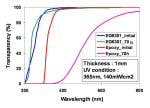Silicone-based materials are attracting considerable attention for use as encapsulants and lenses in a variety of LED device designs. The trends driving silicone materials for LED packaging are higher brightness, longer device lifetime, market growth of blue and white light LEDs, and lead-free solder reflowable processing.
The key attributes of silicones that make them attractive materials for high-brightness (HB) LEDs include their high transparency in the UV-visible region, controlled refractive index (RI), and stable thermo-opto-mechanical properties. Dow Corning is a leader in new material developments related to applications being pursued by the major LED manufacturers. This includes injection-mold processing of novel resin-based silicones, which is a new challenge that must be demonstrated for high-throughput LED device manufacturing.
Properties of silicones
Silicone-based materials have a long history of excellent performance in very demanding applications, such as protective materials for semiconductor devices. Their high optical clarity and stable properties upon exposure to heat and humidity make silicones an excellent choice for use in new, demanding applications such as protective encapsulants and lenses for HBLEDs.
Silicone elastomers and gels are well known for their stress-relieving characteristics and are often used for encapsulating and protecting stress-sensitive electronic devices. Key attributes for silicones in optical applications include:
• High optical transmittance in the UV-visible region
• Can be synthesized to cover a wide range of refractive indices from 1.38-1.58
• Excellent photo-thermal stability
• A variety of cure chemistries for easy processing
• High purity
• A wide range of cured moduli from gels to hard resins.
Silicones for HB-LEDs
Silicones are finding wide applicability as packaging materials for HBLEDs. The silicone polymers can be synthesized as a linear polymer with varying organic groups attached to the silicon atom; this group tailors the refractive index. Silicones are also highly transparent in the UV-visible wavelength region. With minimal to no absorption or scattering losses, light that is produced by the LED is transmitted efficiently through the silicone material.
Silicones can also be formulated to achieve a wide range of cured modulus values. The hardness can range from soft compliant gels, to harder yet flexible elastomers, up to very hard resinous materials. The cured modulus is dictated by two factors: the crosslink density and the ratio of linear to branched silicon species in the polymer.
When compliant gels and soft elastomers are used to encapsulate devices, they provide a soft, stress-relieving character that can cushion the devices from internal and external stresses. A critical characteristic of a good encapsulant is adhesion, and silicones can be designed to have good adhesion to the various substrates and components used to build LEDs.
Another key attribute of silicones is their unique cure chemistry. Silicones developed for the LED market are thermoset materials and as such are cured with a thermal process. This cure system has several advantages; it can be offered in either one-part or two-part compositions, it can be accelerated with heat, it shows little to no cure shrinkage, and there are no cure by-products.
Molding and lens fabrication
Silicone resin-based compositions have been designed for precision molding applications and can be used to fabricate small, complex lenses. Nanometer- and micrometer-sized features can now be replicated on a silicone surface. These new resinous silicones have been successfully fabricated into optical parts using a variety of techniques such as casting, compression molding, and injection molding. Selected examples of molded parts from recent products under development at Dow Corning are shown in Figure 1.
Figure 1 shows three examples of molded parts of different geometries made with silicone hard resin (SR 7010) having a refractive index of 1.53. In the upper left is a picture of a molded button-shaped part, upper right is a molded disc, and in the middle is a hollow lens shape. In all three cases, the molded parts can be released from the mold, using a cycle time as short as one minute, with high optical clarity. The optimal mold process conditions are often not too different from those used to mold traditional thermoplastics. Commercial fabrication of LED lenses has begun by various suppliers using the two-part addition curing silicone compositions.
Photo-thermal stability of silicones
Silicones are highly transparent in the UV-visible wavelength region. It is critical to the LED performance that transparency be retained throughout the lifetime of the device. Because HBLEDs are running at higher junction temperatures, retention of properties upon exposure to high temperatures is critical.
Silicones have been shown to be highly stable when exposed to 370 nm light at 150°C, as opposed to epoxies which easily discolor under equivalent conditions. The UV-stability test results on a silicone elastomer product, EG 6301 (refractive index of 1.4), are shown in Figure 3, benchmarked with an optical-grade epoxy encapsulant.
Summary
Silicones can be designed to accommodate a wide range of refractive indices and cured moduli. They can be formulated to various viscosities, which allows for a wide range of processing options. For LED applications, materials can be either dispensed when used as encapsulants, or molded into lenses. Silicone materials have high transparency and can be formulated for excellent photo and thermal stability as well as excellent retention of their initial transparency throughout the lifetime of the LED devices. Finally, silicones are excellent materials for encapsulating LEDs and for manufacturing discrete optical lenses.
About the Authors
Ann W. Norris and Maneesh Bahadur are with Dow Corning Corporation, PO Box 994, Midland, Michigan 48642, USA and Makoto Yoshitake is with Dow Corning Toray, Chiba, Japan.
Dow Corning Corporation (www.dowcorning.com) is a globally integrated provider of materials, application technology and services, and is focused on providing innovative technology for all segments of the electronics industry. For more information, contact [email protected].








